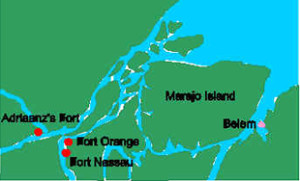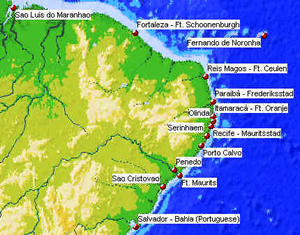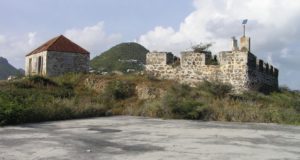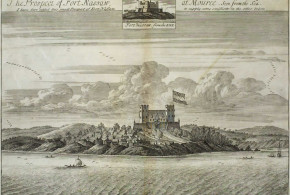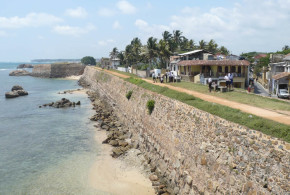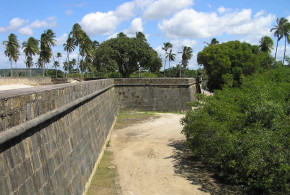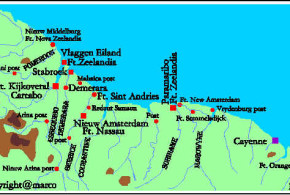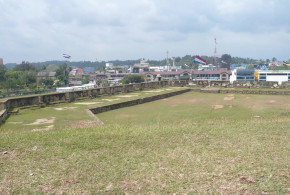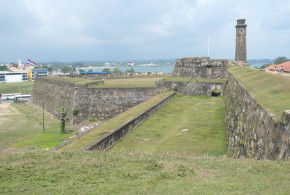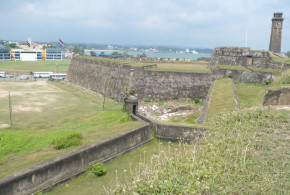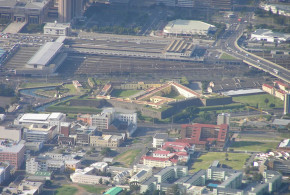Written by Marco Ramerini. English text revision by Dietrich Köster.
THE AMAZON SETTLEMENTS
In 1600, according to Ioannes De Laet, the Dutch possessed two wooden forts (Fort Nassau and Fort Oranje) on the eastern shore of the Xingu River. These had been built by colonists from Zeeland. In 1616, a Zeeland expedition under the command of Pieter Adriaenszoon Ita sailed with 150 men. They arrived on the shore of the Ginipape River where they built a fort on a peninsula.
This colony survived for six years. Historical information about these settlements is incomplete, but for the first twenty years of the XVIIth century the Dutch held some forts in this region. Here they traded with the natives.
THE EARLY ATTEMPT
After the foundation of the WIC (West Indische Compagnie) in 1621 the Dutch set their eyes on the most important town of Portuguese Brazil: Salvador da Bahia de Todos os Santos. The expedition for the conquest of Salvador da Bahia started in December 1623. It totaled 26 sailing ships, 450 guns and 3300 men. The Admiral was Jacob Willekens, the commander of the troops was Jan Van Dorth. The Admiral arrived off Salvador on 8 May 1624. On the morning of 9 May 1624 the Dutch troops landed a few miles from Salvador, advanced and entered the town in the morning of 10 May 1624. The Portuguese governor Diogo de Mendonça surrendered. This conquest turned out to be short-lived. Indeed, on Easter Eve 1625 a Portuguese fleet of 52 ships, 1,185 guns and 12,566 men appeared off Salvador. The Dutch were demoralized and capitulated on 30 April 1625, the day after the Portuguese entered the town. This was the end of the first, but not the last, Dutch attempt to capture Portuguese Brazil.
“NIEUW HOLLAND”
The second and more durable attempt started in the Summer of 1629. This time the objective was Pernambuco, the best sugar colony in Brazil. The commander of the Dutch fleet was Hendrick Corneliszoon Loncq. He arrived at Pernambuco in February 1630 with a fleet of 67 ships, 1,170 guns and 7,000 men. They launched their attack on 15 February 1630 and the action was successful. By the evening of 16 February 1630 the Dutch were in possession of Olinda; by the 3rd of March all Portuguese resistance was over and the Dutch were masters of Recife, Olinda and the island of António Vaz. From 14 March 1630 the Dutch governed their conquests through a political council.
Meanwhile, the Portuguese governor Mathias de Albuquerque organized the resistance. Some fortified camps were built all around Recife, the most important was called Arraial do Bom Jesus, only about three miles from Recife. In May 1631 the Dutch occupied a small island near Itamaracá, where they built a fort called Oranje, which was garrisoned by 366 men under the command of Crestofle d’Artischau Arciszewski, a Polish captain. The Portuguese raids stopped the Dutch in developing their forts. In November 1631 the Dutch abandoned Olinda and tried to conquer the Fort of Cabedelo in Paraíba, the Rio Grande, the Rio Formoso and Cabo de Santo Agostinho, but all these attempts failed. On 20 April 1632 a Portuguese Mulatto, Domingo Fernandes Calabar deserted to the Dutch. He was born at Porto Calvo (Alagoas) and he knew the country very well; his desertion was very useful for the Dutch.
On 1 May 1632 the Dutch occupied the little town of Igaraçu near the island of Itamaracá. In February 1633 the fort on the Rio Formoso was conquered by the Dutch and in March 1633 the “arraial” of Afogados was also conquered and a fort was built there. In June 1633 the island of Itamaracá was occupied and a settlement was founded there; in December 1633 van Ceulen captured the Fort of Reis Magos (Dutch Fort Ceulen) at the mouth of the Rio Grande do Norte. In March 1634 the Dutch occupied a foothold on the “pontal” of Cabo Santo Agostinho. After a short siege the Fort Cabedelo in Paraíba surrendered on 19 December 1634 and the town of Paraíba surrendered a few days later. Now the Dutch controlled the entire coastline from Cabo de Santo Agostinho to Rio Grande.
In March 1635 the Dutch attacked and conquered Porto Calvo. On 8 June 1635, after a siege of three months, the “arraial do Bom Jesus” was also conquered and, a month later, the Fort of Nazaré at Cabo de Santo Agostinho. The Portuguese Governor with over 7,000 persons escaped to the south, but encountered about 500 Dutchmen in the fort at Porto Calvo, which barred his way. He had to attack this place and after a brief siege the Dutch capitulated.
In this attack the Portuguese captured Domingo Fernandes Calabar who was put to death as a traitor. Calabar’s death was a heavy blow to the Dutch. On 24 July 1635 the Dutch reoccupied Porto Calvo, which had been abandoned by the Portuguese on 22 July.
At the beginning of 1636, reinforced by 2,500 men from Portugal, the Portuguese took the initiative. They advanced on Porto Calvo, but its Dutch commander, von Schoppe, evacuated the town. The conquest of Porto Calvo gave the Portuguese the possibility to carry out many raids against Pernambuco, which became rather unsafe for the Dutch. At this time the WIC directorate decided to put a Colonial Governor at the head of the Brazilian colony called Nieuw Holland. Johan Maurits, count of Nassau–Siegen, was the man selected for this office; he was a good choice.
THE GOVERNMENT OF JOHAN MAURITS VAN NASSAU-SIEGEN (1637–1644)
Johan Maurits left Holland on 25 October 1636 and arrived in Recife on 23 January 1637. He was resolved to waste no time in capturing Porto Calvo, which he attacked with a force of 3,000 Dutch soldiers, 1,000 sailors and 1,000 Amerindians on 18 February 1637; the Neapolitan commander Bagnuoli was defeated and the Dutch captured the fort after two weeks of siege. Johan Maurits, sacked the small town of Penedo and built a fort (Fort Maurits) 18 miles from the mouth of the São Francisco River. With the conquest of their first plantation colony, the Hollanders were in need of slaves. Since 1612 they possessed the small fort at Moure on the Gold Coast (presently Ghana), but the Portuguese were the masters of this coast. Indeed, since 1482 they possessed the big fortress of São Jorge da Mina, the most important center of the slave trade. For this aim Johan Maurits sent an expedition to attack Elmina (São Jorge da Mina), the key to the Gold Coast. The fortress capitulated on 28 August 1637. In November 1637 Colonel von Schoppe invaded the province of Sergipe del Rey, and the Neapolitan commander Bagnuoli escaped. In December 1637 also the province of Ceará and the city of Fortaleza were conquered. Now the Dutch controlled half of the then Brazilian provinces. The Portuguese maintained a tenuous control over Salvador and the southern half of Brazil.
However, even Salvador was besieged for a short time in 1638. On 8 April 1638 a Dutch force of 4,600 men (3,600 Dutch and 1,000 Amerindians) attempted to capture Salvador. The Dutch landed, but the garrison of the city was superior in number to the assailants. Johan Maurits decided to risk an assault on 17 and 18 May 1638, which came very near to a success. However, this attack turned out as a major defeat for the Dutch and they retreated on 25–26 May. For as long as the Portuguese held Salvador in their hands, the Hollanders in Brazil would never be in safe condition.
In 1640 Portugal revolted against Spain, restored its independence and the Duke of Bragança was proclaimed King. When Johan Maurits received the news he celebrated it with festivities. But in spite of this the war continued. In 1641 the Dutch reoccupied São Cristóvão (which had been abandoned in 1637), and in November 1641 also the city of São Luís do Maranhão was taken.
An expedition for the conquest of key areas of Portuguese Africa: São Tomé, Angola and Benguela was started. On 23 August 1641 a fleet of 21 ships and 3,000 men under the command of Jol and Henderson anchored off Luanda (Angola) and three days later the city was occupied. Also Benguela (in today’s Angola) was taken and in October the islands of São Tomé (16 October 1641) and Annobon were captured. Finally, in February 1642, the Fort of Axim on the Gold Coast, the last in Portuguese hands was also taken. With these conquests the WIC became the ruler of the whole West African coast. The best slave markets at that time were thus under WIC control.
From the beginning Johan Maurits described Brazil as a beautiful country and he fell in love with it. He was favourably inclined towards the Portuguese planters (moradores) and tolerated the Roman Catholic priests. He gave the colony a form of representative local government through the creation of municipal and rural councils. He developed the country; built streets, bridges and roads in the city of Recife. On the neighbouring island of António Vaz he founded a new town called Mauritsstad or Maurícia, where the first astronomic observatory and meteorological station in the Americas were built on two large sites (called Boa Vista and Vrijburg), which included zoological and botanical gardens. He was a “Maecenas”. In Nieuw Holland famous artists like Frans Post and Albert Eckhout and scientists like Piso, Marcgraf and others arrived from Holland.
The Dutch were, at this time, the masters of the Atlantic Ocean and Recife was, like Batavia in the East, the capital of the WIC (West Indische Compagnie) empire. In 1642, they were masters of Nieuw Amsterdam (today’s New York) and the Nieuw Nederland colony in North America. In the Caribbean they possessed the islands of Curação (today’s Curaçao), Aruba, Bonaire, Sint Eustatius, Sint Maarten, Saba, Tobago, St. Croix. In the Wild Coast (today’s Guiana and Suriname) they possessed colonies on the Essequibo River and the Berbice River, the islands of St. Helena (a VOC possession) and Fernando de Noronha in the Atlantic and the colony of Nieuw Holland or Dutch Brazil. On the West African coast they held the castles of Arguin (Mauritania), Gorée (Senegal), Axim, Butri, Shama, Elmina, Moure (all on the Gold Coast), the islands of São Tomé and Annobon in the Gulf of Guinea; the ports of Luanda and Benguela in Angola.
The Dutch subjects in Brazil were divided into two categories: Those employed by the WIC (soldiers, bureaucrats, Calvinist ministers) called “dienaaren” and the others (settlers, merchants, artisans, and tavern keepers) called “vrijburghers” or “vrijluiden”. Many of these were ex–soldiers, who had married and settled down, but there were also people who had emigrated from the Netherlands to seek a new life in Nieuw Holland. The free–burghers and traders were the economic pillar of the colony, and most of the trade was under their control. But notwithstanding this, the Burgher community in Brazil was too scant for the WIC purposes. In the colony there was also a flourishing Jewish community of 1,450 souls in 1644. The total white civilian population of “vrijburgher” was about 3,000. The Dutch control on Brazil was always endangered, and the WIC failed in its aim of colonization. The majority of the colonists were Portuguese moradores with a different religion and language, who were always ready to revolt against the “heretics”. In October 1642 the province of Maranhão revolted and after one year of fighting the Dutch troops retreated. In April 1642 the directors of the WIC wrote to Johan Maurits, informing him to return to Holland in spring 1643. He was not happy for that and postponed his departure until May 1644.
THE END OF A “NIEUW HOLLAND”
Deprived of the leadership of Johan Maurits, the WIC lost the control over the colony. After his departure the Portuguese planters revolted against Dutch rule and after the battle of Tabocas (3 August 1645), which ended with a Dutch defeat, the Dutch were forced on the defensive. The Portuguese gained control of the “várzea”. The Portuguese forces attacked Serinhaem and the Dutch garrison surrendered on 6 August 1645. On 13 August 1645 the Dutch fortress of the Pontal de Nazaré at Cabo de Santo Agostinho also surrendered.
On 2 September 1645 the “moradores” of Paraíba rose against the Dutch and the Fort of Porto Calvo surrendered on 17 September, followed on 18 September also by Fort Maurits on the São Francisco River. On 22 September Sergipe del Rey in turn rose against the Dutch and at the end of the year 1645 the Dutch possessed only Recife and in its vicinity the Forts of Cabedelo (Paraíba), Ceulen (Rio Grande do Norte), the islands of Itamaracá and Fernando de Noronha.
Due to Recife’s siege by the Portuguese since August 1645, the Johan Maurits palaces and parks and many other buildings at Mauritsstad were razed to the ground for a better defense of Recife. In the besieged capital there were about 8,000 men, but in June, July and August 1646 a relief Dutch fleet reached Recife. In November 1646 Fort Maurits was reoccupied by the Dutch, but the following April the place was abandoned. In February 1647 a Dutch expedition of 26 ships and 2,400 men occupied the island of Itaparicá in the Bay of Todos os Santos. This was to be the last “coup de main”.
A new Portuguese fleet of 15 ships and 3,800 men left Portugal on 18 October 1647 under the command of António Teles de Menezes, Count of Vila–Pouca de Aguiar and governor of Brazil. On 7 November 1647 another Portuguese fleet of 7 ships and 600 men left Lisbon under the command of Salvador Correia de Sá e Benavides, although his final objective was Luanda. On 13 December 1647 the Dutch evacuated Itaparicá.
A new Dutch fleet under Witte de With left Holland the day after Christmas 1647 and arrived – in Recife in March 1648. In the night of 17–18 April 1648 a Dutch squadron of 5,000 men under Commander von Schoppe attacked the Portuguese forces in the “várzea” and scored a first success. However, in the morning of 19 April 1648 the Portuguese (only 2,200 men) launched an attack at the Guararapes, which turned out to be an overwhelming victory. The Dutch left 500 dead and 556 wounded. Shortly thereafter the Portuguese reoccupied Olinda.
The Dutch in Recife were again besieged. On 12 May 1648 Salvador Correia de Sá with 15 ships and 2,000 men left Rio for Luanda in an attempt to retake it. He succeeded in retaking Luanda on 24 August 1648. At the end of the year 1648 the Dutch forces in Brazil totaled about 6,000 white men and 600 Amerindians.
On 18 February 1649 a Dutch force of 3,500 men occupied the Guararapes. The Portuguese commander Francisco Barreto marched against them with a force of 2,600 men and the subsequent battle of 19 February was a overwhelming victory for the Portuguese, and the Dutch left 957 dead.
A Dutch expedition under Mathias Beck landed in April 1649 in Ceará, which had been abandoned at the end of 1643 and founded a new fort called Schonenburgh.
In February 1650 the situation of the Dutch at Recife, closely besieged by land, was very precarious, and the 3,000 men garrison was demoralized. There were about 8,000 civilians, of which roughly 3,400 were vrijburghers, 600 were Jews and 3,000 to 4,000 were Amerindians or Negroes. The shortage of food and provisions was the worst enemy. The strength of the garrisons of Nieuw Holland was about 4,000 men including the garrisons in Paraíba and in Rio Grande do Norte.
On 20 December 1653 a Portuguese fleet of 77 ships appeared off Recife. Meanwhile and unlike the situation during 1650 the depots of the town were full of provisions, but at this time the garrison was quite unprepared to offer resistance.
On 22 January 1654 the Dutch asked for terms of surrender, and on 26 January 1654 the capitulation was signed. Not only Recife but all the places still in Dutch hands were included: Paraíba, Ceará, Rio Grande do Norte, Itamaracá, Fernando de Noronha. The Portuguese made their triumphal entry into Recife on 28 January 1654 and the WIC never recovered from the loss of Nieuw Holland.
BIBLIOGRAPHY:
– Various Authors, “Tempo dos Flamengos e outros tempos. Brasil século XVII”, 351 pp., Fundação Joaquim Nabuco – Editora Massangana, 1999, Recife, Brazil, Seminário Internacional em comemoração aos 500 anos do descobrimento, 18 articles on Dutch Brazil. Index: Tambores de Marte em Guararapes; Nassau: uma perspectiva cultural em Pernambuco; Nassau no Recife: aspectos culturais da ocupação do espaço urbano; António Vieira e o tempo dos Flamengos: retórica anti-holandesa e alvitrismo político económico; A revelação do Brasil por João Maurício de Nassau; Flamengos e Ibéricos no Nordeste Brasileiro; Padroado Português e missionação nos tempos dos Flamengos; Igreja sociedade e poder; Presença Flamenga no Nordeste; Calvinismo Holandês e libertade religiosa; Igreja, reforma, contra-reforma e estado em Pernambuco no sêculo XVII; Pernambuco e Angola; A cidade do Recife – urbanismo lusitano e holandês; Portugal e Holanda no Pernambuco setecentista; Luís Cardoso; Pernambuco na história da companhia geral do comércio do Brasil; Réflexions sur les géopolitiques atlantiques – le cas du Brésil au XVIIème siècle; Algumas notas críticas sobre a história da restauração portuguesa (1640-1668).
– Barlaeus, Gaspar “História dos feitos recentemente praticados durante oito anos no Brasil”, prefácio de José Antônio Gonçalves de Mello, Fundação de Cultura Cidade do Recife, 1980, Recife, Brazil. Gaspar van Baerle, alias Gaspar Barlaeus (1584-1648) was a humanist, who accompanied Count Johann Moritz von Nassau-Siegen to Brazil in order to write the history of his administration for the Dutch Crown in Pernambuco (1637-44). The result was this book, a major title in rare Brasiliana, published in Latin (Amsterdam 1647). The printer and publisher, Johann Blaeu, included 55 prints after drawings by Frans Post in the first edition. They covered many cities in Northeastern Brazil other than Pernambuco, but also important places in Portuguese Africa and Chile.
– Bezerra, Rubens Borges, “Moedas holandesas em Pernambuco, Dutch coins in Pernambuco”, 136 pp., illustration, Gráfica e Editora, 1980, Recife, Brazil.
– Boxer, Ch. R., “The Dutch in Brazil 1624-1654”, xiii, 327 pp., 4 maps, Oxford University Press 1957, London, United Kingdom. A complete study on the Dutch presence in Brazil. I think, it is the best about Dutch Brazil.
– Cabral de Mello, E., “Olinda restaurada, guerra e açucar no Nordeste 1630 – 1654”, 470 pp., Topbooks Editora, 2° edição, 1998, Rio de Janeiro, Brazil
– Di Pace, Vittorio, “Napoletani in Brasile nella guerra di liberazione dall’invasione olandese: 1625-1640”, 129 pp., [42], con tavole, illustrazioni, Casa Editrice Fausto Fiorentino, 1991, Naples, Italy.
– Doria, Gino, “I soldati napoletani nelle guerre del Brasile contro gli olandesi, 1625-1641”, in: Archivio Storico per le Province Napoletane, a.57, 31 pp., Ricciardi editori, 1932, Napoli.
– Edmundson, “The Dutch on the Amazon and Rio Negro in the Seventeenth Century”, English historical review: 1903, Vol. XVIII, pp. 642 – 663 and 1904, Vol. XIX, pp. 1 – 25. Article dealing with the Dutch settlements in the Amazon basin.
– Edmundson, “The Dutch power in Brazil. The struggle for Bahia 1624-1627”, English historical review: 1896, Vol. XI, 231 – 259 pp.
– Edmundson, “The Dutch power in Brazil. The first conquest”, English historical review: 1899, Vol. XIV, 676 – 699 pp.
– Girão, Raimundo, “Matias Beck, fundador de Fortaleza”, 168 pp., Imprensa Oficial do Ceará, 1961, Fortaleza, Ceará, Brazil.
– Gonçalves de Mello, J. A. Neto, “Tempo dos Flamengos: influência da ocupação holandesa na vida e na cultura do Norte do Brasil” 337 pp., José Olympio, 1947, Rio de Janeiro, Brazil. The Dutch heritage in Northern Brazil. Index: Os Holandeses e a vida urbana, os Holandeses e a vida rural, atitude dos Holandeses para com os Negros e a escravidão, atitude dos Holandeses para com os Índios e a catequese, atitude dos Holandeses para com os Portugueses e os Judeus e as religiões católica e israelita.
– Herkenhoff, Paulo, “Brasil e os Holandeses 1630-1654”, 272 pp., color plates, maps, plans, GMT Editores Ltda., 1999, Rio de Janeiro, Brazil. Beautifully illustrated volume on Dutch influence in Brazil in the 17th century. Essays covering Art, Architecture, Urbanism, Cartography, Science and Religion.
– Krommen, Rita, “Mathias Beck e a Cia. das Índias Ocidentais: o domínio holandês no Ceará colonial”, 310 pp., illustrations, Casa de José de Alencar, 1997, 1. edition, Fortaleza, Brazil. Tese de Graduação apresentada à Universidade de Colónia.
– Nederveen Meerkerk, H. van, “Recife. The rise of a 17th-century trade city from a cultural-historical perspective”, 459 pp., illustrations, van Gorcum, 1989, Assen-Maastricht, The Netherlands. The history of architecture in Recife of the years of Dutch occupation.
 Colonial Voyage The website dedicated to the Colonial History
Colonial Voyage The website dedicated to the Colonial History
